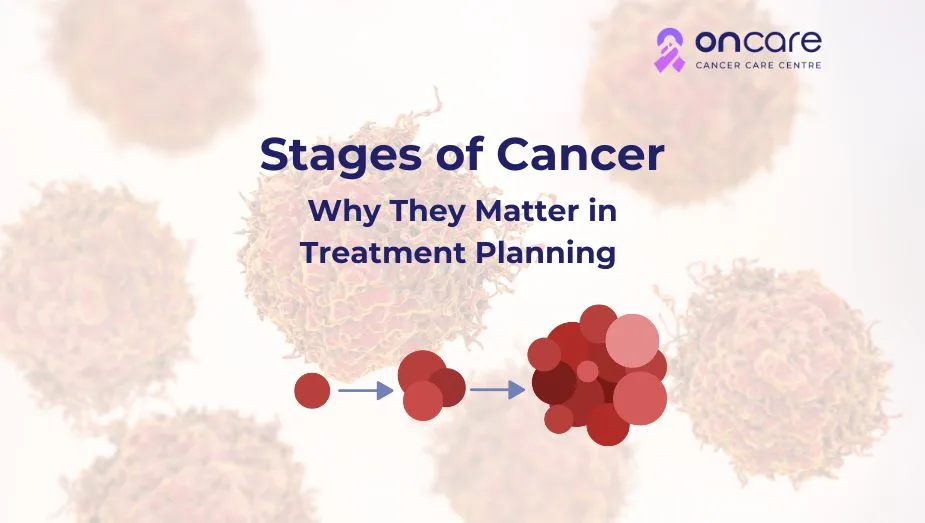Table of Contents
How Many Stages of Cancer: Learn How Doctors Classify Cancer

Anyone can feel scared, confused, or overwhelmed when they hear the word "cancer." People often ask, "How many stages of cancer are there?" right after they find out they have cancer. Knowing what the different stages of cancer are can help you feel less scared about the whole thing. You can better understand your treatment options and talk to your doctor with more confidence if you know what the stages mean. We will use very simple language to explain the stages of cancer in this article so that you can feel more informed and in charge.
What Does "Stage of Cancer" Really Mean?
A cancer stage tells you how much cancer is in the body and how far it has spread. Doctors use stages to figure out the best way to treat the cancer and how quickly it might spread. The stage also tells you what to expect while you're getting treatment. Staging is like a map. Doctors can plan the safest and strongest way to fight cancer if they know exactly where it is and how big it is.
How Many Stages of Cancer Are There?
Stages 0 to 4 are the five main stages of most cancers. The basic idea is almost always the same, even though there may be small differences in staging for different types of cancer.
These stages help you figure out if the cancer is small and only in one place or if it is bigger and spreading to other parts of the body. Let's go over each step in simple, clear language.
Stage 0: The Cancer Is Only on the Outside
Stage 0 cancer means that doctors have found cells that are not normal, but they have not spread to other parts of the body. Some people call this stage "carcinoma in situ."
The cancer has not spread to nearby tissues yet. It is usually very early and easy to treat. A lot of the time, doctors can get rid of or destroy these cells before they become a problem.
Stage 1: The cancer is small and only in one place
Stage 1 cancer means that the tumor is still small and hasn't spread to other organs or lymph nodes. People often call it early-stage cancer.
At this point, treatment is usually easier. Radiation, targeted therapy, or surgery may be all that is needed to get rid of the cancer completely. A lot of people who find cancer at this stage do very well.
Stage 2: The cancer has spread but is still in the same area
In Stage 2, the cancer is bigger than it was in Stage 1 and may have moved a little into nearby tissues, but it hasn't spread very far yet. It might be close to lymph nodes but not inside them at times.
At this point, doctors often use stronger combinations of treatments. Depending on the type of cancer, they might suggest surgery along with chemotherapy or radiation.
Stage 3: Cancer has spread to the lymph nodes close by
Stage 3 cancer means that the tumor is bigger and that cancer cells have spread to nearby lymph nodes. The immune system has small, bean-shaped parts called lymph nodes. When cancer gets to them, it could mean that the disease is trying to spread.
Stage 3 sounds scary, but a lot of people still respond very well to treatment. Doctors usually use a combination of treatments, such as surgery, chemotherapy, radiation, and newer targeted therapies.
Stage 4: The cancer has spread to other parts of the body that are far away
Stage 4 is the most advanced. It means that cancer has spread from where it started to other parts of the body, like the liver, lungs, or bones. This is also known as metastatic cancer.
Stage 4 doesn't mean there is no hope. There are a lot of treatments that can help keep the cancer under control, slow its growth, ease symptoms, and make life better. Thanks to modern medicine, some people with Stage 4 cancer can live for many years.
Why Staging Is So Important
Staging helps doctors see how the cancer is acting. It answers important questions, such as:
- How big is the tumor?
- Has it spread?
- How fast is it growing?
Without staging, treatment would be a shot in the dark. When you stage something, you plan every step carefully and scientifically. It also helps doctors choose the best treatment for you by letting them compare your case to millions of others around the world.
How do doctors figure out what stage the cancer is in?
To find out what stage of cancer a person is in, doctors do several tests. Blood tests, scans, biopsies, or surgery are all possible tests. Each test tells you something different about the cancer.
For instance:
- A scan can show how big the tumor is.
- A biopsy can tell you how aggressive the cells are.
- A blood test can show how the body is dealing with the illness.
Doctors can tell you the exact stage when they put all of this information together.
The TNM System: A Different Way for Doctors to Sort Cancer
Doctors often use the TNM system in addition to stages 0 to 4. TNM stands for:
- T for the size of the tumor
- N for node involvement (lymph nodes)
- M for Metastasis (the spread of cancer to other organs)
The number after each letter shows how bad the cancer is. For instance, T1 means a small tumor, and T4 means a big one. N0 means that the cancer hasn't spread to the lymph nodes. N1 or higher means that the cancer is in the nodes. M0 means there is no spread to other parts of the body, while M1 means it has spread to other organs.
The TNM system shows a lot of details about the cancer. It helps doctors choose the best treatment.
Is the way cancers are staged the same for all of them?
Most cancers use the standard staging system, but some, like blood cancers, use different ones. Leukemia and other cancers do not form solid tumors. Instead, doctors classify them by how many abnormal cells are in the blood or bone marrow.
The goal is always the same, even though the details are different: to find out how far along the disease is and how to best treat it.
Why it's so important to find things early
Finding cancer early, like at Stage 0 or Stage 1, can make it easier to treat and more likely to work. It is possible to completely cure many cancers that are still in their early stages. This is why it's so important to get regular checkups, screenings, and pay attention to how your body changes.
Finding it early can save your life. A lot of people only find out they have cancer when their symptoms get bad. But cancer can often be treated long before any symptoms show up. This is why doctors tell people to get screening tests like mammograms, Pap tests, and colonoscopies.
Consult Today
Knowing how many stages of cancer there are can help you understand your diagnosis and treatment plan. There are clear, proven treatments for each stage, but they all have their own problems. Hope and healing are always possible, no matter what stage you're in.
Oncare Cancer Hospital has advanced treatments, skilled doctors, and caring staff to help you or a loved one who has cancer. Their team will work with you at every step to give you the best and most personalized cancer care.
Frequently Asked Questions
There are usually five main stages: 0, 1, 2, 3, and 4.
No. Thanks to modern treatments, a lot of people with Stage 4 cancer can live for years.
Yes, a lot of Stage 0 and Stage 1 cancers can be completely cured.
Oncare Cancer Hospital is known for its great care, cutting-edge technology, and highly skilled doctors.
Book an Appointment
Related Blogs

What Cancers Can Cause Itchy Skin? How Itching Could Indicate Underlying Cancer
Learn what cancer can cause itchy skin, why certain cancers trigger itching, how to tell harmless itching from serious symptoms, and when to see a doctor.

Stages of Cancer: Why They Matter in Treatment Planning
Explore the different types of cancer stages, TNM staging, and how cancer is staged on the basis of size and location, and its importance in cancer treatments!

Understanding the Stages of Breast Cancer and Their Impact on Treatment
Stages of Breast Cancer & Importance of Early Detection | Learn How Timely Diagnosis Can Improve Treatment Success & Boost Chances of a Cure

